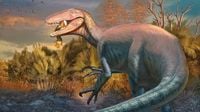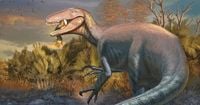On a windswept plain in Patagonia, Argentina, a team of scientists recently unearthed a remarkable fossil that is rewriting what we know about the last days of the dinosaurs. The find? A new species of megaraptoran dinosaur, Joaquinraptor casali, whose fossilized jaws were locked around the arm bone of a prehistoric crocodile. The discovery, published on September 23, 2025, in Nature Communications, is being hailed as one of the most complete—and intriguing—megaraptor skeletons ever found.
The story of Joaquinraptor begins with a chance observation. In 2019, Lucio Ibiricu, a paleontologist from the Patagonian Institute of Geology and Paleontology, and his colleague Bruno Alvarez were surveying the ancient rock formations of Chubut Province. According to National Geographic, Alvarez noticed a small bone fragment jutting from the ground—a clue that led the team to an extraordinary discovery months later. Excavations revealed a partial skeleton: the skull, arms, parts of the legs, ribs, vertebrae, and, most curiously, a crocodile arm bone pressed into the dinosaur’s jaws.
“At this moment, we realized the discovery was one of the most important for the team,” Ibiricu told National Geographic. The skeleton was found in the Lago Colhue Huapi rock formation, a fossil-rich region dating to the very end of the Cretaceous period, about 66 to 70 million years ago—just before the asteroid impact that wiped out most dinosaur life.
Measuring over 23 feet long and weighing more than a ton, Joaquinraptor casali was a formidable predator. With its elongated snout and stout arms tipped in impressively long, curved claws, it would have been a terrifying sight on the prehistoric floodplains of what is now southern Argentina. As CBS News reported, megaraptorans like Joaquinraptor were known for their stretched-out skulls and “huge and very powerful claws,” making them the apex predators in their ecosystems.
But what sets this discovery apart is the fossilized evidence of Joaquinraptor’s last meal. The presence of a crocodile arm bone, wedged between its jaws, offers a rare glimpse into the dietary habits and hunting strategies of these enigmatic carnivores. Fossils that preserve such direct evidence of prehistoric diets are exceedingly rare. “Fossilized behavior, if that’s really what this is, comes along so rarely that you’ve just got to celebrate it when it does,” said Matthew Lamanna, a paleontologist with the Carnegie Museum of Natural History, in an interview with National Geographic.
Unlike the more famous Tyrannosaurus rex, which dominated North America, megaraptorans like Joaquinraptor thrived in South America, Australia, and parts of Asia. They evolved into different species over millions of years, filling ecological niches left open in regions where tyrannosaurs never roamed. According to Reuters, “Megaraptorans are among the least understood dinosaurs of all,” Ibiricu explained. Their fossils are often fragmentary, making it difficult for paleontologists to reconstruct their evolutionary history or understand their behavior.
The discovery of Joaquinraptor casali helps fill a major gap in our understanding. “The new discovery offers interesting novelties about the survival of megaraptorid dinosaurs up to the very end of the Mesozoic,” Fernando Novas, a paleontologist from the Bernardino Rivadavia Natural Sciences Argentine Museum, told National Geographic. Novas, who previously discovered another megaraptor species, was not involved in this particular find but emphasized its significance: the new species indicates that megaraptors were both numerous and diverse in South America right up to the mass extinction event.
What about the crocodile bone? Was Joaquinraptor really caught mid-meal? The evidence is compelling. The bones of Joaquinraptor were found largely in articulation—meaning they were still connected in life position—and the crocodile bone was the only other animal bone present at the site. This suggests the dinosaur was buried with its last meal, rather than the remains being mixed together by water or scavengers. “If it is just coincidence,” Lamanna told National Geographic, “then Mother Nature is playing a cruel joke on Lucio, myself, and our coauthors, because several things about this dino-croc association are super weird.”
The scientific community is abuzz with the implications. The specimen is considered “the most completely represented and latest-surviving megaraptorans” ever found, according to AP. It provides a rare window into the predatory strategies of these dinosaurs. Study co-author Matt Lamanna noted to Reuters that, unlike T. rex—with its massive teeth and tiny arms—Joaquinraptor likely used its long arms and claws to capture and subdue prey. “This suggests that these two predatory dinosaur lineages evolved different adaptations to accomplish basically the same thing—that is, to capture, subdue, kill and eat other animals such as other dinosaurs,” Lamanna said. “Precisely why these groups evolved along these different evolutionary pathways remains a mystery, but it shows that, during the Cretaceous, there was more than one way to be a top predator.”
For Lucio Ibiricu, the discovery is deeply personal. He named the new species in memory of his son Joaquin, who died very young. “All children love dinosaurs so he would probably be a fan too,” Ibiricu told CBS News. It’s a poignant reminder of how scientific discovery is often intertwined with human stories—and how the past can echo into the present in unexpected ways.
The research, published in Nature Communications on September 23, 2025, has already sparked new questions. What other secrets might megaraptorans hold? Could further discoveries reveal more about their evolutionary origins or their sudden disappearance? As paleontologists continue to probe the fossil-rich soils of Patagonia, one thing is certain: Joaquinraptor casali has given the world a rare, vivid snapshot of prehistoric life at the very edge of extinction.
With every new fossil, the shadowy world of the megaraptorans grows a little clearer. Joaquinraptor’s final meal, frozen in stone, is a tantalizing clue—a reminder that sometimes, the most extraordinary stories are the ones that survived by chance.






